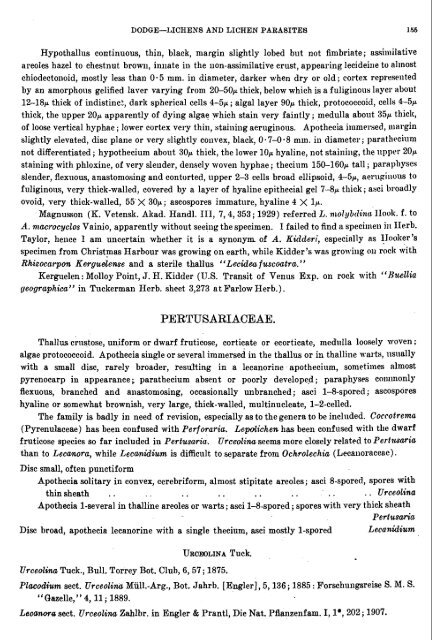You also want an ePaper? Increase the reach of your titles
YUMPU automatically turns print PDFs into web optimized ePapers that Google loves.
DODGE-<strong>LICHEN</strong>8 <strong>AND</strong> <strong>LICHEN</strong> <strong>PARASITES</strong> 165<br />
Hypothallus continuous, thin, black, margin slightly lobed hut not fimbriate; assiinilative<br />
areoles hazel to chestnut brown, innate in the lion-assimilative crust, appearing lecideii~e to allnost<br />
chiodectonoid, mostly less than 0-5 mm. in diameter, darker when dry or old; cortex represellted<br />
by an amorphous gelified laver varying from 20-5OP thick, below which is a fuliginous layer about<br />
12-18p thick of indistinc:, dark spherical cells 4-5p; algal layer 90p thick, protococcoid, cells 4-5r.<br />
thick, the upper 2OP apparently of dying algae which stain very faintly; medulla about 35p thick,<br />
of loose vertical hyphae ; lower cortex very thin, staiiliilg aeruginous. Apothecia immersed, i~iargin<br />
slightly elevated, disc plane or very slightly convex, black, 0.7-0.8 mm. in diameter ; paratllt.cium<br />
not differentiated ; hypothecium about 30p thick, the lower 10p hyaline, not staining, the ripper 20~ staining with phloxine, of very slender, densely woven hyphae; thecium 150-160~ tall; paraphyses<br />
slender, flexuous, anastomosing and contorted, upper 2-3 cells broad ellipsoid, 4-5p, aeruginous to<br />
fuliginous, very thick-walled, covered by a layer of hyaline epithecial gel 7-8~ thick; asci broadly<br />
ovoid, very thick-walled, 55 X 30p; ascospores immature, hyaline 4 X lP.<br />
Magnusson (K. Vetenslt. Altad. Handl. 111, 7,4,353 ; 1929) referred L. n~olybtli~~ct IIook. f. to<br />
A. ntacrocyclos Vainio, apparently without seeing the specimen. I failed to find a speciinel~ ill Ilerb.<br />
Taylor, hence I am uncertain whether it is a synonym of A. Kirlderi, especially 8s ITo(11ter's<br />
specimen from Christmas Harbour was growing on earth, while Kidder's was growing 011 rock with<br />
Rhizocarpon Kargudense and a sterile thallus "Lecidea fuscoatra."<br />
Kerguelen: Molloy Point, J. 11. Kidder (1J.S. Transit of Venus Exp. on rock with "Hzcellia<br />
geographica" in Tuckerman Herb. sheet 3,273 at Farlow Herb.).<br />
PERTUSARIACEAE.<br />
Thallus crnstose, uniform or dwarf fruticose, corticate or ecorticate, med~~lla loosely woven ;<br />
algae protococcoid. Apothecia single or several immersed in the thallus or in thalline warts, nsnally<br />
with a small disc, rarely broader, resulting in a lecanorine apothecinm, sometimes almost<br />
pyrenocarp in appearance; parathecium absent or poorly developed; paraphyses cotiilnonlg<br />
flexuous, branched and anastomosing, occasionally unbranched; asci 1-Sspored; ascospores<br />
hyaline or somewhat brownish, very large, thick-walled, multinucleate, 1-2-celled.<br />
The family is badly in need of revision, especially as to the genera to be included. Coccotrema<br />
(Pyrenulaceae) has been confused with Perforaria. Lepolichen has been confused wit11 tlie dwarf<br />
fruticose species so far included in Pertusaria. Urceolina seems more closely related to Perttcsaria<br />
than to Lecmora, while LecMtidium is difficult to separate from Ochrolechia (Lecanoraceae).<br />
Disc small, often punctiform<br />
Apothecia solitary in convex, cerebriform, almost stipitate areoles; asci 8-spored, spores with<br />
thin sheath . . . . . . . . . . . . . . . . Urcedina<br />
Apothecia 1-several in thalline areoles or warts; asci I-8-spored ; spores with very thick sheath<br />
Pertusaria<br />
Disc broad, apothecia lecanorine with a single thecium, asci mostly 1-spored Lecanidium<br />
URCWLINA Tuck.<br />
Urceolina Tuck., Bull. Torrey Bot. Club, 6,57; 1875.<br />
Placodium sect. Urceolina Miil1.-Arg., Bot. Jahrb. [Engler], 5,136 ; 1885 : Forschuilgsreise S. M. S.<br />
"Gazelle," 4, 11 ; 1889.<br />
Lecmwg, sect. Urceolina. Zahlbr. in Engler & Prantl, Die Nat. Pflanzenfam. I, l', 202; 1907.

















